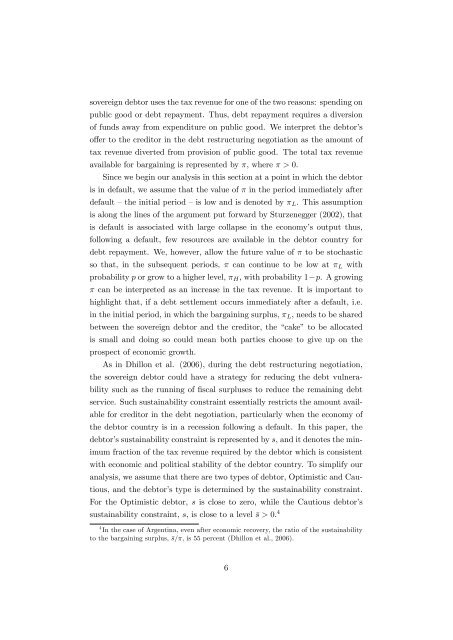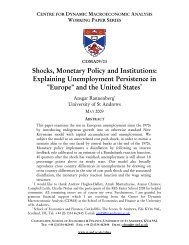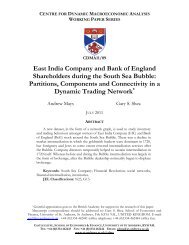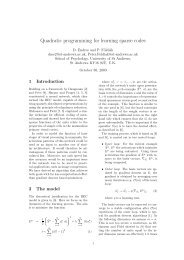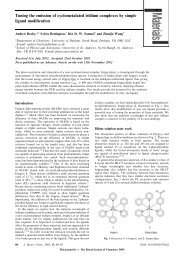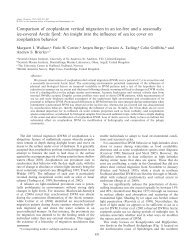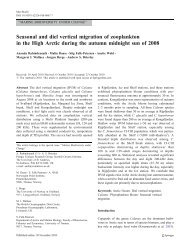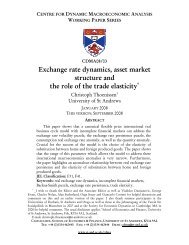Delay and Haircuts in Sovereign Debt - University of St Andrews
Delay and Haircuts in Sovereign Debt - University of St Andrews
Delay and Haircuts in Sovereign Debt - University of St Andrews
You also want an ePaper? Increase the reach of your titles
YUMPU automatically turns print PDFs into web optimized ePapers that Google loves.
sovereign debtor uses the tax revenue for one <strong>of</strong> the two reasons: spend<strong>in</strong>g on<br />
public good or debt repayment. Thus, debt repayment requires a diversion<br />
<strong>of</strong> funds away from expenditure on public good. We <strong>in</strong>terpret the debtor’s<br />
o¤er to the creditor <strong>in</strong> the debt restructur<strong>in</strong>g negotiation as the amount <strong>of</strong><br />
tax revenue diverted from provision <strong>of</strong> public good. The total tax revenue<br />
available for barga<strong>in</strong><strong>in</strong>g is represented by , where > 0.<br />
S<strong>in</strong>ce we beg<strong>in</strong> our analysis <strong>in</strong> this section at a po<strong>in</strong>t <strong>in</strong> which the debtor<br />
is <strong>in</strong> default, we assume that the value <strong>of</strong> <strong>in</strong> the period immediately after<br />
default –the <strong>in</strong>itial period –is low <strong>and</strong> is denoted by L . This assumption<br />
is along the l<strong>in</strong>es <strong>of</strong> the argument put forward by <strong>St</strong>urzenegger (2002), that<br />
is default is associated with large collapse <strong>in</strong> the economy’s output thus,<br />
follow<strong>in</strong>g a default, few resources are available <strong>in</strong> the debtor country for<br />
debt repayment. We, however, allow the future value <strong>of</strong> to be stochastic<br />
so that, <strong>in</strong> the subsequent periods, can cont<strong>in</strong>ue to be low at L with<br />
probability p or grow to a higher level, H , with probability 1<br />
p. A grow<strong>in</strong>g<br />
can be <strong>in</strong>terpreted as an <strong>in</strong>crease <strong>in</strong> the tax revenue. It is important to<br />
highlight that, if a debt settlement occurs immediately after a default, i.e.<br />
<strong>in</strong> the <strong>in</strong>itial period, <strong>in</strong> which the barga<strong>in</strong><strong>in</strong>g surplus, L , needs to be shared<br />
between the sovereign debtor <strong>and</strong> the creditor, the “cake” to be allocated<br />
is small <strong>and</strong> do<strong>in</strong>g so could mean both parties choose to give up on the<br />
prospect <strong>of</strong> economic growth.<br />
As <strong>in</strong> Dhillon et al. (2006), dur<strong>in</strong>g the debt restructur<strong>in</strong>g negotiation,<br />
the sovereign debtor could have a strategy for reduc<strong>in</strong>g the debt vulnerability<br />
such as the runn<strong>in</strong>g <strong>of</strong> …scal surpluses to reduce the rema<strong>in</strong><strong>in</strong>g debt<br />
service. Such susta<strong>in</strong>ability constra<strong>in</strong>t essentially restricts the amount available<br />
for creditor <strong>in</strong> the debt negotiation, particularly when the economy <strong>of</strong><br />
the debtor country is <strong>in</strong> a recession follow<strong>in</strong>g a default. In this paper, the<br />
debtor’s susta<strong>in</strong>ability constra<strong>in</strong>t is represented by s, <strong>and</strong> it denotes the m<strong>in</strong>imum<br />
fraction <strong>of</strong> the tax revenue required by the debtor which is consistent<br />
with economic <strong>and</strong> political stability <strong>of</strong> the debtor country. To simplify our<br />
analysis, we assume that there are two types <strong>of</strong> debtor, Optimistic <strong>and</strong> Cautious,<br />
<strong>and</strong> the debtor’s type is determ<strong>in</strong>ed by the susta<strong>in</strong>ability constra<strong>in</strong>t.<br />
For the Optimistic debtor, s is close to zero, while the Cautious debtor’s<br />
susta<strong>in</strong>ability constra<strong>in</strong>t, s, is close to a level s > 0. 4<br />
4 In the case <strong>of</strong> Argent<strong>in</strong>a, even after economic recovery, the ratio <strong>of</strong> the susta<strong>in</strong>ability<br />
to the barga<strong>in</strong><strong>in</strong>g surplus, s=, is 55 percent (Dhillon et al., 2006).<br />
6


